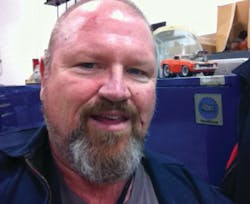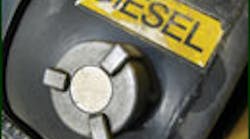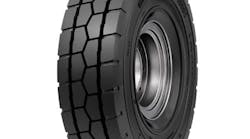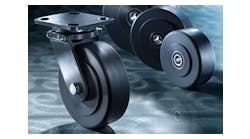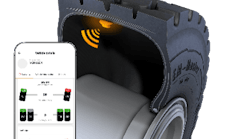Turbochargers are being installed on many hungry diesels from beltlo aders to air starts. One reason is that the EPA believes it cuts down on pollutants from these typically smoky engines.
Turbochargers definitely produce more power. To create that extra power, turbochargers ram more air into the cylinder. This makes the turbocharged engine not only more powerful relative to its size, but also makes it run more efficiently than a regular combustion engine that relies on atmospheric pressure. Making a diesel engine more effiicent means less black soot on first throttle that we've all come to admire.
To do all this, a turbocharger is powered by engine exhaust gas that spins a turbine. The turbine then spins a compressor, drawing in air from outside, compresses it and pumps it back into the cylinders, thereby delivering a boost in engine power. A turbocharged engine can generate as much as 40 percent more power than a non-turbocharged engine. It also cuts down fuel costs and emissions by up to 15 percent compared to a non-turbocharged engine.
Turbochargers make most of us think of Detroit muscle cars from the 1970s. But actually, turbochargers are a product from the 19th century. The principles of forced induction were first used with internal combustion engines in 1885. A Swiss engineer named Alfred Buuchi received a patent in 1905 for the turbocharger basics we still use today to use exhaust to force more air into a diesel engine.
There the idea sat unused until air power became a part of warfare during World War I. In this case, the extra power compensated for the thin air at higher altitudes.
GSE?
As long as the “G” in “GSE” stands for “ground” we don’t have to worry about flak from where we do our jobs. Or do we? Flak, at least the non-lethal kind, always accompanies new environmental regulations. And while much of the EPA regulations, by and large, affect turbocharged engines in the light truck market, they still have plenty of impact on GSE.
The main reason for the turbocharger in GSE is the lag in delivering oxygen during the initial throttle. Squirt some fuel and you better have a good charge of air to combust the fuel. We're not interested in speed, of course, as much as we are in horse power torque.
New orders always come with secondary costs and new ways to think. Turbocharged engines, for example, not maintained by regular oil changes fail. It’s that simple.
But simple things not done can cost a mind-boggling amount of dollars. Over-heating and loss of power come to mind, naturally. But if the turbocharged engine powering an air start shuts down during the process, there could major damage to aircraft. You definitely want something like an air start to cough the moment you need it.
In the matter of of oil changes, I can really blame the fact that turbocharged diesel engines need high quality oil. The bearings of turbos are red hot in moments after the engines run for a few seconds. Problems come from the oil that circulates around this bearing. Shut it off and the oil cooks to carbon, slowly but surely blocking the oil flow.
If you have an engine at full-out screaming rpms, and then abruptly shut it off as many average Joes do, it will fail. Maybe not today. Maybe not tomorrow. But definitely when you need it most. That's an "always."
But wait there’s more!
Follow the exhaust, and you’ll see it goes to a catalytic converter. What you’ll see in this cat is a honeycomb of fine metal. The exhaust is hot enough to make these babies glow.
Inside this unit is a very costly mixture of fancy chemicals that try to burn all the unspent fuel. Well, if the turbo bearings fail and spew oil into the system, it passes the pistons to pile on the honeycomb.
No biggy at first … until it piles so thick you start to lose power. The morning starts are harder. Sometimes people just assume the engine is tired. Change out the engine, right? Oh yeah. Twelve thousand dollars later, the same problem!
There are a few things you can do to prevent this:
- Change your oil. Often. An oil change is nothing compared with expensive repairs and down time.
- Know your engine. Many times I wonder why the cat isn't bolted on instead of welded for inspection. Pressure sensors could give awareness of upcoming problems. I sometimes whip out my infrared temperature laser and look at exhaust temps.
But the best advice I can give you is to change the oil if you love the engine (which goes without saying). I've never seen a manufacturing warranty say changing the oil “often” will void it.
Finally, here's another wonderful, not well-thought-out thing - the location of the air filter often affects the whole system. The filter should not be exposed to the crazy blow by of a big diesel. But it does and, naturally, this plugs the filter and cuts down airflow. If you've continued to change the oil and still are having issues, this might be a place to start.
This is just some of the typical things that as a mechanic I come across day after day. It's almost second nature to know right off what's wrong with these air-huffing engines. I wonder if an engineer that designed it ever changed the oil in one.
Change the oil, please. Often.
Guy Ruff Jr. has been maintaining GSE for US Airways for the past 25 years. "From heavy turndowns to details," he writes in his LinkedIn profile. "Too many to list." Ruff started his career as a plater for miltary-grade electronics at Sunstrand Data Control and got involved in the Hubble telescope; Mx cruise missles; and the F-18 fighter jet.
